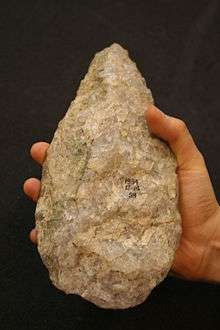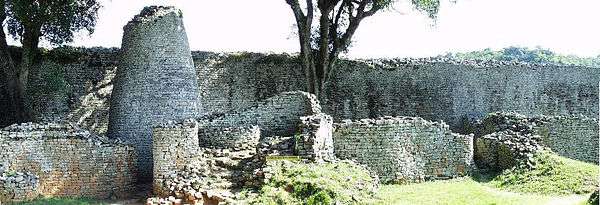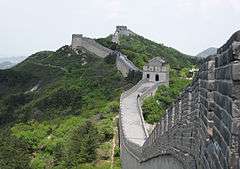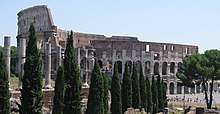Historical travel
Historical travel includes various kinds of destinations, from Stone Age cave paintings to Cold War installations of the late 20th century. History is a central focus for some travellers and some destinations, and almost every traveller in most places will at least have a look at some old buildings or the local museums.
Understand
| “ | History does not belong to us but rather we to it. | ” |
—Hans-Georg Gadamer | ||
The early history of life on Earth is studied in paleontology, mainly through fossils. The earliest known fossils of the genus Homo date back at least 4.4 million years. Our species, Homo sapiens, is thought to have evolved between one and two hundred thousand years ago. Some homo sapiens migrated from Africa to the Middle East about 100,000 years ago and to Europe about 60,000 years ago.

The boundary between paleontology and archaeology, which deals mainly with the study of ancient human artifacts, is not at all well-defined. The oldest known tools made by hominids — Oldowan stone tools excavated in the Olduvai Gorge of Tanzania — are about 2.6 million years old. Australopithecines, of the genus which had included direct ancestors of Homo, had cruder stone tools starting at least 3.3 million years ago. Controlled use of fire is apparently at least a million years old.
The boundary between archaeology and history is also hard to define, and they overlap whatever boundary you choose. By one widely-used definition, real history starts with the beginning of written records, 3000-4000 BCE, apparently first in the Indus Valley Civilization in what's now Pakistan and a bit later in Ancient Egypt and Ancient Mesopotamia. However, one might also take earlier dates, based on various important developments. Pottery, the wheel, the first domesticated animals (dogs), and the first evidence of crop cultivation all appeared between 30,000 and 20,000 BCE. A number of other important developments took place between about 12,000 BCE and 3,000 — the transition of some societies from purely hunting/gathering to being based on agriculture, irrigation, cities, metalworking, and domestication of many more animals.
For purposes of this article, anything after 50,000 BCE counts as history. Naturally this overlaps considerably with our archaeology article.
The line between "historical" and "modern" is arbitrary; some draw it around the time of the European Renaissance or slightly later with the great voyages of discovery starting with Columbus and Vasco da Gama. For travel guide purposes it is more convenient to draw it at the Industrial Revolution in the 18th and 19th centuries, when cities, industries and railroads began to expand fast, displacing older structures. Surviving settlements and city districts from before the mid-19th century which were designed before and survived the advent of cars and trains, referred to as Old Towns, are typically smaller and more compact (and thus walkable) than modern cities. However, during the 19th and 20th centuries, older styles of art, architecture and furnishing have been revived and reproduced, so that many buildings that look ancient, might be younger than 100 years. There might even be a (neo)Gothic train station or an Ancient Greek-style building in the Americas.
Deserted settlements can be archaeological sites or ghost towns. Pioneer villages can be authentic or artificial. In some places you quite literally trip over historical remnants, whereas other historic sites have been painstakingly preserved and restored. While the latter is usually more interesting it may seem "fake", "sterile" or even "artificial" when done badly. Also — with few exceptions — there are fewer lines (if any) for historical places that people actually still live in (like old towns) or use for their original purpose (like many churches / mosques / synagogues / temples) than for museums or "theme parks".
Nostalgia tourism aims at recent history, remembered by people alive today (especially the middle-aged and elderly). As of the 2010s, it includes World War II, as well as postwar United States, Cold War Europe and the Soviet Union.
Some historical sites are threatened, either for natural causes or human-influenced ones like war or neglect. As of the late 2010s, cities such as Venice and New Orleans are sinking into the sea, ancient ruins in Iraq and Syria are damaged by modern warfare, and many indigenous cultures around the world have only a handful of survivors left. Future generations are in no way guaranteed to experience these places as they are. Responsible travel can provide incentives to save them, or at least their memory.
Continents and regions
Africa

Africa is the wellspring of the human race and therefore the site of the oldest finds of human remains, in locations ranging from South Africa to Ethiopia. It was also home to some of the world's oldest civilizations, particularly Ancient Egypt but also Nubia and Ethiopia. A bit later in antiquity, Carthage dominated much of North Africa and was then conquered by the Romans, who did major construction projects in their African provinces as they did in all other parts of their empire, leaving behind substantial ruins. In addition, there were great empires in both the Sahel and Southern Africa in the centuries before European colonialism; some of these relics have been recently vandalized by Salafist extremists, such as in northern Mali, but a lot is still standing. Perhaps the two most prominent pre-colonial sites in sub-Saharan Africa are Timbuktu in Mali and the Great Zimbabwe in Zimbabwe. Arab and Berber/Moorish civilization also has left deep and lasting marks on North Africa, and the Arabs, especially the Sultanate of Oman, had far-flung possessions down the East African coast, notably including Zanzibar and Mombasa. There are also many relics of European colonialism, including slave forts and other forts on the coasts. Locations associated with the trans-Atlantic slave trade, World War II battles, the fights for independence and the fight against Apartheid in South Africa can also be visited; see 20th-century South Africa.
Antarctica
The only unsettled continent has very few traces of human history. Some Antarctic islands, such as the South Georgia Island and South Shetland Islands, have remnants of the whaling industry. The remains of expeditions of the "heroic age" of Antarctic exploration can still be seen and some have been actively preserved or relocated to museums in Europe and elsewhere. Many former research stations have been abandoned to be "swallowed" by snow and ice, and there aren't always many traces visible.
Asia

Asia had some of the world's oldest civilizations, including those in Ancient Mesopotamia, the Indus Valley, Persia, Anatolia, Syria, Phoenicia, Israel, the Edomites and Moabites of Jordan, China, India and Java, to name a few. The Middle East contains the world's first cities; some old towns have been inhabited for three millennia or more. The Holy Land is sacred to Judaism, Christianity, Islam and the Baha'i Faith.
Iran is one of the oldest countries on the earth. You may have heard names of emperors like Cyrus the Great or Ardashir I. The Achaemenid Empire was a really big empire which consisted of many states. The Silk Road had a very important role during this empire. The language of the Persian Empire was Persian.
The Asian nation that lacks archaeological relics is much more the exception than the rule. Much has been lost due to iconoclasm, such as in Malaysia several hundreds of years ago, when the relatively new Muslims destroyed Malay Hindu temples; in Saudi Arabia within the last few years, when numerous historical sites were razed in Mecca and other places; in Afghanistan, when statues of the Buddha that were thousands of years old were dynamited by the Taliban; and in Iraq and Syria today, when the Islamic State group is destroying many of the larger Babylonian and other historical relics they can get their hands on and spiriting many of the smaller relics out of the country to sell on the black market.
For more recent history, the "Hippie Trail" of the 1960s and 70s is covered in Istanbul to New Delhi over land. Parts of what was the usual route back in the day are currently too dangerous, but the journey is still possible using alternate routes.
- Ancient Mesopotamia
- Persian Empire
- Imperial China
- Chinese Revolutions
- Long March - a significant military event during the Chinese civil war in the 20th century that forged the Communist party
- Western Xia - a lost ancient Chinese civilization
- Mongol Empire
- Silk Road - an ancient trading route that provided cultural and technology interchange between the east and west
- On the trail of Marco Polo
- Pre-modern Japan
- Pre-modern Korea - the history of the Korean people before the 20th century
- Korean War - the 20th century conflict at the beginning of the Cold War
- South Asian history
- Mughal Empire
- Colonial India
- British Raj - the British empire in the Indian subcontinent
- Philippine Revolution
- Pacific War - the Second World War in the Asia-Pacific region
- Khmer Empire
- Indochina Wars
Europe

- See also: European history
Europe has been more thoroughly excavated by archaeologists than any other continent. Southern Europe has archaeological sites from Ancient Greece, the Roman Empire and other ancient civilizations. Central Europe in particular is filled with medieval castles and early-modern palaces, with Old towns across the whole continent. However, Europe's heritage has been scarred by war, especially World War II. The Holocaust was not just a genocidal campaign against the Jews, the Nazis also set out to methodically destroy Jewish heritage. Many beautiful synagogues were destroyed and never rebuilt due to - among other things - lack of a Jewish congregation, lack of funds or personal and institutional continuities. Jewish cemeteries, too, were vandalized. As the Second World War left many cities bombed beyond recognition, many city planners saw their opportunity to replace the "old fashioned" old towns with (in today's eyes) bland 1950s architecture and big streets and overpasses to make these places "ready for the automobile". Although the worst excesses have been turned back, many historical buildings that survived the wars were torn down in this somewhat iconoclastic frenzy.
Historical tourism itself has a long history in Europe; educational journeys such as the Grand Tour have been customary since the 17th century.
- Prehistoric Europe
- Celts
- Ancient Greece
- Roman Empire
- Vikings and the Old Norse (until 1000 AD)
- Nordic history (since 1000 AD)
- Hanseatic League
- Medieval and Renaissance Italy
- Ottoman Empire
- Russian Empire
- Spanish Empire
- Atlantic slave trade
- Thirty Years' War
- Napoleonic Wars
- Austro-Hungarian Empire
- Industrial Britain
- German East Africa
- British Empire
- World War I
- French Colonial Empire
- World War II in Europe
- D-Day Beaches
- Holocaust remembrance
- Soviet Union
- Cold War Europe
Oceania

The first humans arrived at New Guinea and Australia 40,000 years ago; this places their indigenous cultures among the oldest known on Earth. Without writing or metalworking, their heritage is sourced from their artwork and oral tradition. See Indigenous heritage in Australia. The first settlers of the Solomon Islands arrived more than 30,000 years ago.
The rest of Oceania has a remarkably short human history, though. The Austronesians (who trace their origin to Taiwan) were the first people to arrive in Polynesia; from 1,000 BC and onwards. They reached Hawaii in the 4th century AD, and New Zealand in the 13th century, making the North and South Islands the last major landmasses on Earth to be settled (other than Antarctica). Oceania was also among the last regions to be charted and colonized by Europeans.
North America
.jpg)
- See also: North American history
North American pre-history has left behind sites such as the New Mexico Pueblos and Ohio prehistoric sites. n addition, in Mexico and Central America, especially Guatemala, there are very impressive remains of the Mayan civilization, particularly quite a number of pyramids.
Sites associated with written history begin with early contact between indigenous peoples of North America and European colonists. Often the indigenous were displaced by European settlers and sometimes killed (for example, the infamous Trail of Tears).
Early colonial sites are often preserved as "old towns" in Atlantic coastal cities such as Antigua Guatemala, Granada (Nicaragua), Quebec City, Havana, San Juan, or St. Augustine But there are also old cities inland, notably Santa Fe, New Mexico.
Early settlements that did not develop into major cities are often preserved (or reconstructed) as outdoor museums or "pioneer villages", like Louisbourg, Plymouth (Massachusetts), and Williamsburg.
Military tourism on this continent is focused on the American Revolution, War of 1812, the Mexican-American War, the American Civil War and the various "Indian Wars" between the colonists and the indigenous peoples.
African-American history includes sites related to the Atlantic slave trade as well as the Underground Railroad: multiple routes for smuggling slaves who had escaped the southern US across the northern states into what later became Canada (at the time British North America) or other non-US territory. Active primarily in the 1850s, when US federal law left slaves who had escaped to free states in immediate danger of recapture by slave catchers unless they left the US entirely.
History-focused itineraries include the Camino Real, the Royal Road linking the 21 Spanish missions of California; the Lewis and Clark Trail leading across the Western United States, following the route of explorers Lewis and Clark; the Oregon Trail which took settlers to the Pacific coast; the Ruta del Tránsito, the historic route from east to west across North America that passed through Nicaragua; Route 66 existed from 1926-1985, but continues to be marketed for nostalgia tourism; and the American Industry Tour from 17th century Massachusetts, to 20th century Chicago.
For the politically-included there is also the the chance to see sites related to the Presidents of the United States.
United States History series
Note that most of these topics are not exclusive to the United States. Indigenous cultures did not conform to modern boundaries and are thus equally present in Canada and Mexico. Colonial boundaries were also different that modern ones: British colonial history includes Bermuda and Nova Scotia as much as the "13 colonies" of U.S. school textbooks. Even the American War of Independence was partially fought in present-day Canada. Even after the establishment of the modern boundaries, trends and events touched multiple countries; those interested in the Old West will also find cowboy culture in Northern Mexico and the Canadian Prairies.
- Indigenous cultures of North America
- Early United States history (1492 to 1861)
- American Civil War (1861 to 1865)
- Old West (mainly 1865 to 1900)
- Industrialization of the United States (1865 to 1945)
- Postwar United States (1945 to present day)
South America

Many people travel to Peru every year to see the Inca Trail and other historical sites from the Inca Empire. Other historical sites include the remnants of the Falklands War and the history of the Jesuit missions in Paraguay. Beautiful colonial old towns can be found all over the continent, especially in Argentina and Chile, whose mineral wealth made them some of the richest countries in the world during the early 20th century.
Themes
The great epics
Some of the oldest and most famous works of literature are epic poems about great heroes. In all cases there is some dispute among scholars about the historical authenticity of these stories, and about the dates of both the events described and the composition of the text.
The Epic of Gilgamesh is the oldest known piece of literature. It tells tales of a Sumerian king who probably ruled in the first half of the 3rd millennium BCE and of a great flood. The best-known version was likely written around 1200 BCE. While a surprising number of copies survive for a text of that age, they are not all written in the same language and sometimes disagree significantly on details.
Other great epics were written a few hundred years BCE and describe events around 1000 BCE:
- Homer recounts the story of the Trojan War in two epics, the Illiad and the Odyssey. Today Troy is an archeological site which attracts tourists.
- The Mahabarata is a great Indian epic. Perhaps the most famous passage in India literature is the Baghavad Gita, a dialog between the warrior Arjuna and the God Krishna which takes place just before the climactic battle. That battle was fought at Kurukshetra, which now attracts both pilgrims and tourists.
- The Ramayana is another great Indian epic. An epic battle was fought between the forces of the hero, Rama, and the villain, Ravana, on the island of Lanka, which is widely believed to be modern day Sri Lanka.
- The Bible is a more complex set of books than can be encompassed by the term "epic", but much (though not all) of the history recounted therein has been verified by archaeology and/or other ancient writings. The Torah (Pentateuch or Five Books of Moses) was first written down in full in the 6th century BCE, with fragments having been found that date to the 7th century BCE. As in the case of most epics, it is widely believed that some or all of the Torah was passed down orally before being written. See Holy Land, Judaism and Christianity for Biblical destinations. When reading biblical texts with a historical eye, keep in mind that many texts of the ancient Middle East tended to exaggerate numbers that made rulers look impressive such as army sizes, harem sizes and feats of city building, so the "real deal" when finally verified by archeologists can fall short of the epic scales of the tales.
Espionage history
- See also: Spies and secrets
Espionage has existed since ancient times, and sometimes made or broken the fate of nations.
Science and technology tourism
- See also: Science tourism, Industrial tourism, Nuclear tourism
Science tourism is for those with an interest in science, including science museums as well as live science research centers and exploratory missions. Closely related is industrial tourism, factory tours and museums describing manufacturing in various time periods from the start of the Industrial Revolution to the modern era.
Aviation history also has many interesting destinations.
Industrial tourism includes visits to historical or present-day industrial sites and museums. Heritage railways, mining tourism, steam, and certain underground works are a subset of industrial tourism.
Nuclear tourism is for those with an interest in the nuclear industry from either a science or military perspective. The locations can either contain live reactors or be otherwise of interest from a historical point of view.
History of justice
- See also: History of justice
Judicial tourism includes visits to courthouses, police buildings, prisons, crime scenes, and other places related to the legal system.
Military tourism
- See also: Military tourism
Military tourism is for those with an interest in current or historical military sites and facilities, including museums, battlefields, cemeteries and technology.
Types of locations
See also
- Cemeteries
- Grand old hotels
- Fiction tourism and Literary travel
- Heritage railways
- Monarchies
- Some Tourist trains also focus on a supposed or actual historical connection
- Reenactment and LARP
- UNESCO World Heritage List